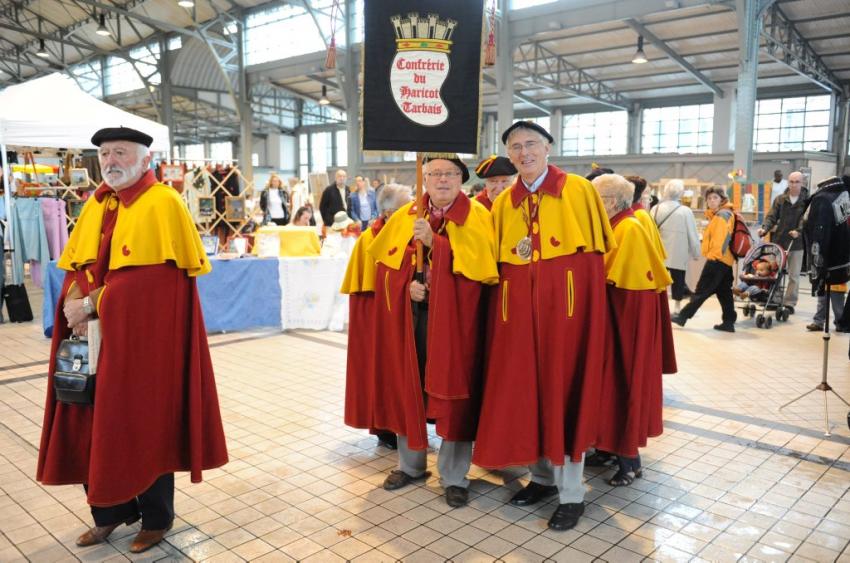Not your average legume, Tarbais beans are an edible tour de force. Today, on National Bean Day, we’d like to take a moment and honor these haricots.
These ultra-creamy French beans are the quintessential ingredient in cassoulet – but they’re good for much more. From their unique growing conditions to their distinctive texture and luminous white color, these beans have an interesting story. So dip in for a little history about these extraordinary beans.

A Brief History of Tarbais Beans
The bean was first brought to Europe by Christopher Columbus, and it adapted well to the sunny, dry climate and rocky soil of the Southwest of France.
 It is said that when Catherine de’ Medici, the future wife of Henry II of France, arrived at Marseilles in 1533, she carried with her a bag of beans given to her by her brother as a wedding gift. She was known to have brought many Italian cooking techniques, which inspired a culinary revolution in France.
It is said that when Catherine de’ Medici, the future wife of Henry II of France, arrived at Marseilles in 1533, she carried with her a bag of beans given to her by her brother as a wedding gift. She was known to have brought many Italian cooking techniques, which inspired a culinary revolution in France.
But it is the Bishop of Tarbes that usually gets credit for championing the bean after a visit to Spain. He began to grow beans in his own garden in the 17th century, and with his encouragement (and blessing) the bean was introduced to the farmers of his region of Tarbes.
The Haricot Tarbais flourished at the foot of the Pyrénées and its cultivation secrets were passed down from generation to generation.
Grown for Greatness
The Haricot Tarbais is a type of pole bean planted in May alongside corn, another New World crop, a system whereby the corn stalk acts as a pole to support the vigorous bean vine, which can grow to 8 feet. Tarbais beans must be laboriously picked by hand, as they are entangled with corn stalks and continue to flower all season. The Tarbais beans are sold fresh or semi-dry as they are picked, from late August through September. But many are fully dried on the vine, and it is these that are picked in October, and destined for the traditional cassoulet of the region.
Save the Beans
Tarbais beans and their labor-intensive production methods dropped out of favor in the 1950s, when more industrialized methods of farming were introduced to the region. It took a severe decline in the number of Tarbais beans to awaken the concern of a group of traditionalists in the mid-1980s. They and the department of agriculture set out to cultivate the Tarbais beans and protect them from vanishing.

 As a result of their effort, the Tarbais bean was the first bean to be granted the “Label Rouge” in 1997, and in 2000 it obtained IGP status (Indication of Protected Geographical Origin). Only members of a small, closed cooperative in Tarbais are allowed to use that name for their beans, and production is tightly regulated. They all grow a single strain, Alaric, which is harvested entirely by hand, in the old way. True Tarbais beans are identified with the term “Label Rouge” on the packaging, which ensures that the Tarbais bean is a traditional local product of outstanding quality.
As a result of their effort, the Tarbais bean was the first bean to be granted the “Label Rouge” in 1997, and in 2000 it obtained IGP status (Indication of Protected Geographical Origin). Only members of a small, closed cooperative in Tarbais are allowed to use that name for their beans, and production is tightly regulated. They all grow a single strain, Alaric, which is harvested entirely by hand, in the old way. True Tarbais beans are identified with the term “Label Rouge” on the packaging, which ensures that the Tarbais bean is a traditional local product of outstanding quality.
Best Bean for Cassoulet
It would be impossible to talk about Haricot Tarbais and not discuss the traditional cassoulet. This dish has ignited passions in the Southwest of France for generations, each town claiming their version to be the one true recipe for cassoulet.
The miracle of the Tarbais bean is that most beans will remain whole during cooking, but just enough beans will burst and help to thicken the cassoulet during its many hours in the oven. Many people in the region claim this thin-skinned bean is the only one suitable for making cassoulet. We agree, and import French Coco Tarbais Beans – Label Rouge, of course – for that very reason.

For those seeking the traditional flavors, we offer an easy-to-follow Cassoulet Recipe Kit. The generous kit feeds around 12 people, so makes the perfect meal for a large crowd at the holidays (or anytime!). We find it is best enjoyed with a few bottles of wine from the Southwest France (we like Madiran in particular).

I have made your cassoulet and have on question. Is the cassoulet cooked properly once the beans are soft, but whole, or later after they get more creamy and somewhat disintegrated?
Thanks, Jeff
The ideal state of doneness would include a bit of both, Jeff. Some of the beans should burst and contribute to a creamy texture, but you certainly want the majority of them to whole and soft.
I may just have to try these beans and see what all the fuss is about👍
We hope you will!